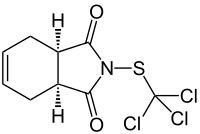Captan
| Structural formula | ||||||||||||||||
|---|---|---|---|---|---|---|---|---|---|---|---|---|---|---|---|---|

|
||||||||||||||||
| General | ||||||||||||||||
| Surname | Captan | |||||||||||||||
| other names |
|
|||||||||||||||
| Molecular formula | C 9 H 8 Cl 3 NO 2 S | |||||||||||||||
| Brief description |
white to yellow solid with a faint mercaptan odor |
|||||||||||||||
| External identifiers / databases | ||||||||||||||||
|
||||||||||||||||
| properties | ||||||||||||||||
| Molar mass | 300.59 g mol −1 | |||||||||||||||
| Physical state |
firmly |
|||||||||||||||
| density |
1.74 g cm −3 |
|||||||||||||||
| Melting point |
|
|||||||||||||||
| solubility |
practically insoluble in water (<0.5 mg l −1 at 25 ° C) |
|||||||||||||||
| safety instructions | ||||||||||||||||
|
||||||||||||||||
| MAK |
Switzerland: 5 mg m −3 (measured as inhalable dust ) |
|||||||||||||||
| Toxicological data | ||||||||||||||||
| As far as possible and customary, SI units are used. Unless otherwise noted, the data given apply to standard conditions . | ||||||||||||||||
Captan is a chemical compound from the phthalimide group .
Extraction and presentation
Captan can be obtained by reacting 1,2,3,6-tetrahydrophthalimide with trichloromethanesulfenyl chloride (perchloromethyl mercaptan) in the presence of sodium hydroxide .
properties
Captan is a flammable white to yellow (technical product) solid with a weak mercaptan- like odor, which is practically insoluble in water. It decomposes when heated and hydrolyzes slowly under neutral and rapidly under basic conditions.
use
Captan is used as an active ingredient in crop protection products. It is used as a fungicide against a number of diseases. Captan was first approved in the United States in March 1949. Over 1400 t of Captan are used there annually - mostly in viticulture and fruit growing.
In fruit growing, captan is used as a contact fungicide against fungal storage rot and apple scab .
Admission
The active ingredient Captan was approved for use as a fungicide in the European Union with effect from October 1, 2007.
In many EU countries, including Germany and Austria, as well as Switzerland, plant protection products (e.g. Malvin, Merpan) with this active ingredient are approved.
history
Captan is believed to be a carcinogen . For reasons of user safety (inhalation of captan dust when filling), the approval that had existed since 1971 was not extended in 1986. It was not until 2001 that Captan was approved again in Germany as a non- dusting, water - dispersible granulate (WG).
Web links
- Poisons Information Monograph (PIM) for Captan
- EFSA: Peer review of the pesticide risk assessment of the active substance captan , June 4, 2009, doi : 10.2903 / j.efsa.2009.296r
Individual evidence
- ↑ a b c d e f g h i j k l entry to captan in the GESTIS database of IFA , accessed on January 9, 2019(JavaScript required) .
- ↑ Entry on Captan in the Classification and Labeling Inventory of the European Chemicals Agency (ECHA), accessed on August 1, 2016. Manufacturers or distributors can expand the harmonized classification and labeling .
- ↑ Swiss Accident Insurance Fund (Suva): Limit values - current MAK and BAT values (search for 133-06-2 or Captan ), accessed on November 2, 2015.
- ^ Entry on Captan in the Hazardous Substances Data Bank , accessed April 2, 2013.
- ↑ Thomas A. Unger: Pesticide synthesis handbook . 1996, ISBN 0-8155-1401-8 , pp. 454 (English, limited preview in Google Book search).
- ^ A b Terence Robert Roberts, DH Hutson: Metabolic pathways of agrochemicals . Royal Soc of Chemistry, 1999, ISBN 0-85404-499-X (English, limited preview in Google book search).
- ^ Robert Irving Krieger, Handbook of Pesticide Toxicology: Principles . 2001, ISBN 0-12-426261-9 , pp. 1712 (English, limited preview in Google Book Search).
- ↑ Directive 2007/5 / EC of the Commission of February 7, 2007 amending Council Directive 91/414 / EEC to include the active substances captan, folpet, formetanate and methiocarb
- ^ Directorate-General for Health and Food Safety of the European Commission: Entry on Captan in the EU pesticide database; Entry in the national registers of plant protection products in Switzerland , Austria and Germany ; accessed on February 23, 2016.
- ↑ Answer of the Federal Government to the minor question from Ms. Hönes, Werner (Dierstorf) and the DIE GRÜNEN parliamentary group - printed matter 10/5953 - non- renewal of the approval of 36 plant protection products with the active ingredients Captan, Captafol and Folpet (September 22, 1986)





